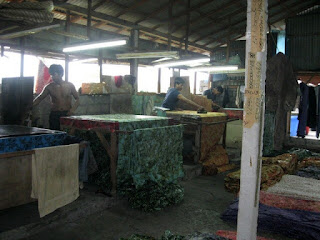 |
| stopped off to see this black sand beach and put my toes in the Indian Ocean |
 This is what I saw when we pulled up. The drying fields. All the color you see in this picture are batiks drying in the sun.
This is what I saw when we pulled up. The drying fields. All the color you see in this picture are batiks drying in the sun.Below, these batiks have been dyed and carried outside, and are crinkled by hand to create the design and sprinkled with soda to make the sort of bubbly look in the fabric.
 |
| Carrying out the wet dyed fabric |
 |
| crinkling the fabric |
 |
| sprinkling with soda and they might also add another color here |
The sun is necessary to "cure" the fabric and this dark fabric above that they were working on was probably discarded as it started to rain after we left, and rain hard, so there was no saving it. If it had been a lighter color, it could have gone back in to be dyed again.
The batiks go to be stamped and should have said earlier on that these stamps are actually called Tjaps (pronounced chops).
 |
| ready to be stamped |
It is wicked hot in these spaces due to the wax pots. This is one of five factories in this space. The guys are paid by the piece so it is up to them how long they work. I would last about five minutes.
This guy is doing a continuous design. His precision is just amazing, like a dance as he applies the stamp, making a perfect pattern, stamping three to four times before it goes back in the wax.

What you see here is the guy in the foreground pumping propane to keep a hot fire burning under the vat of boiling water. The guy up top with the stick is stirring the fabric to remove the wax and set the dye. I think he has the worst job - so hot.

The guys in the water tanks are rinsing the batiks and passing them along to be boiled.

I felt the water and it is cool so I would pick this job - although they must look like prunes from the waist down when they get out. Just saying.

Then, they go out to the drying fields. Almost all of these workers are Javanese. It was explained to me by Yogi, that the Javanese are like the Mexicans in this country. That they send money home to their families, and go home for the month of August, at which time Hoffman has to close down. When I asked why the Balinese didn't work here, Yogi said well, the Balinese don't really need to work. They have their land and their inheritances and I'll tell you more about that later. So.
 |
| mom and kids in the field |
When the fabric comes here, it is checked twice for quality control. First, every yard is looked at by hand for defects, or dye errors, etc. Also, a few samples are taken of each and washed and put out to dry to make sure they match the previous batches.

Then, every single yard is looked at on a light box by two people.

The yardage is measured.
 I think the pieces are 80 to 100 yards. The next pictures are of batiks being laid out on long tables and ironed, layer by layer, up to 40 layers to make Bali Pops and Jelly Rolls. (And if you don't know what those are, well you are not a quilter!)
I think the pieces are 80 to 100 yards. The next pictures are of batiks being laid out on long tables and ironed, layer by layer, up to 40 layers to make Bali Pops and Jelly Rolls. (And if you don't know what those are, well you are not a quilter!)

It was amazing to watch the guy cut through all of those layers. I had no idea this was how it was done and truthfully, I never really thought about it . . .


These people are sitting outside under a shelter doing the packaging. Pleasant out of the sun and so quiet. We were absolutely drooling over the packages. Oh the colors.
 |
| Packaging Bali Pops |
 |
| Geese hanging out in the yard |
And, rolled on with one of the few machines I saw.
Then loaded into a pick-up to start the journey to California.
 |
| These people are readying bolts. |
What a fantastic experience. I feel like the luckiest person in the universe. Oh, and I want to say that I'm sure I made some errors in trying to convey what I saw here so please forgive me for that.












Fab trip, can anyone go to this factory? If so do you have a contact as we as a quilters sewing friendship group are off to Bali and would love to see this..
ReplyDeleteSorry I never revisited this post until now! But if anyone else is interested, I believe that World of Quilts Travel, whom I went with, has special dispensation to go to Hoffman. I don't think it is open to the public.
ReplyDelete